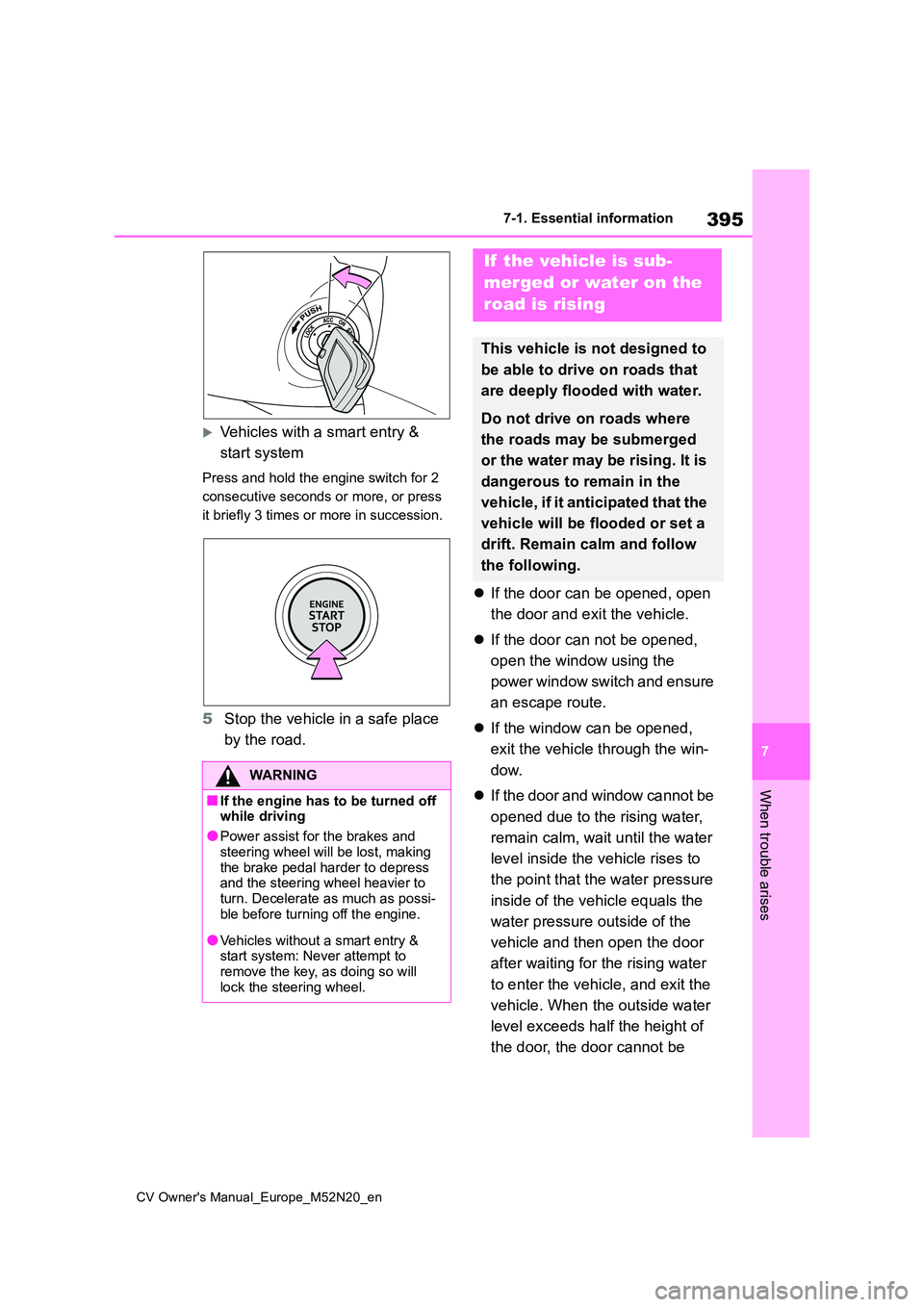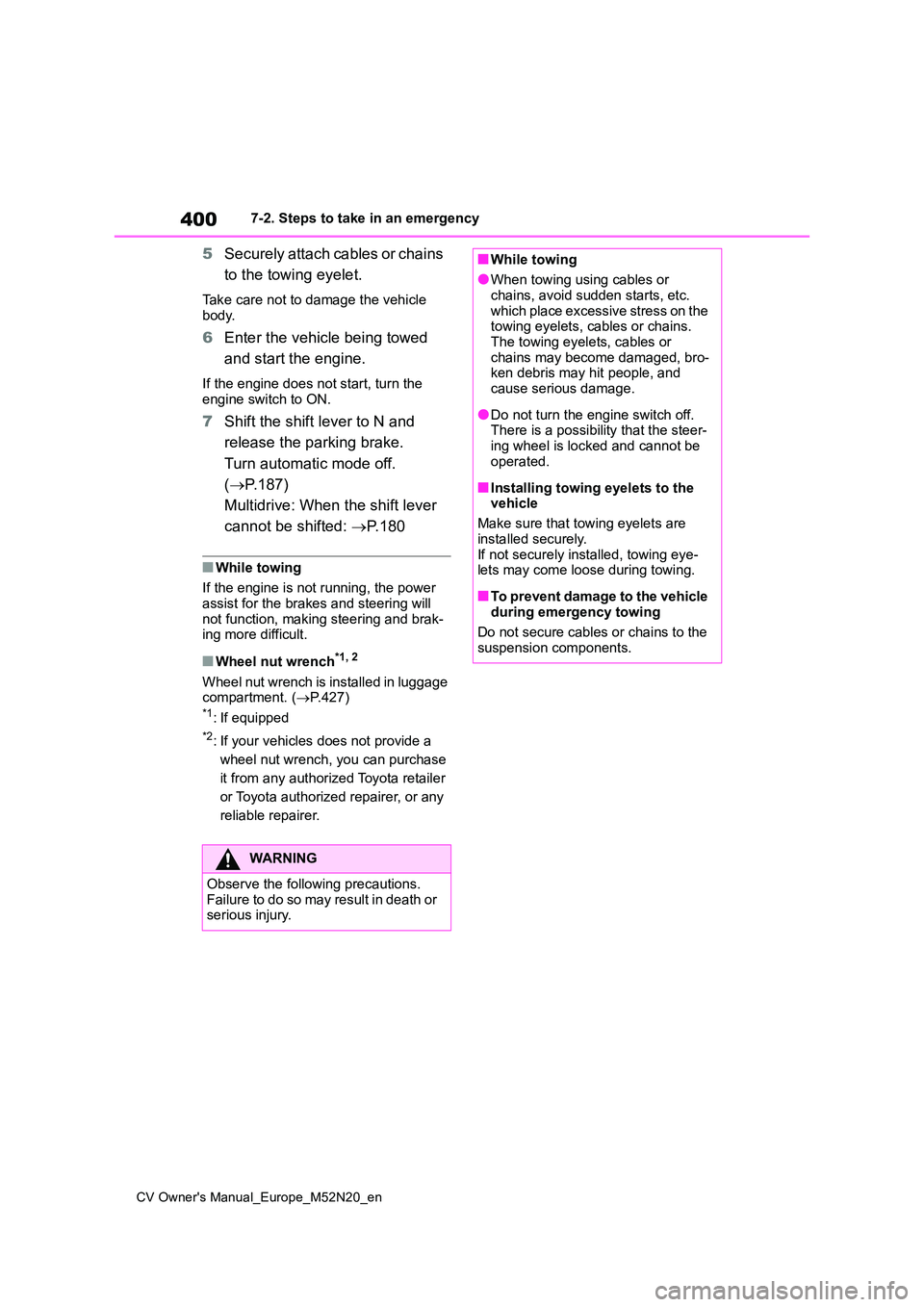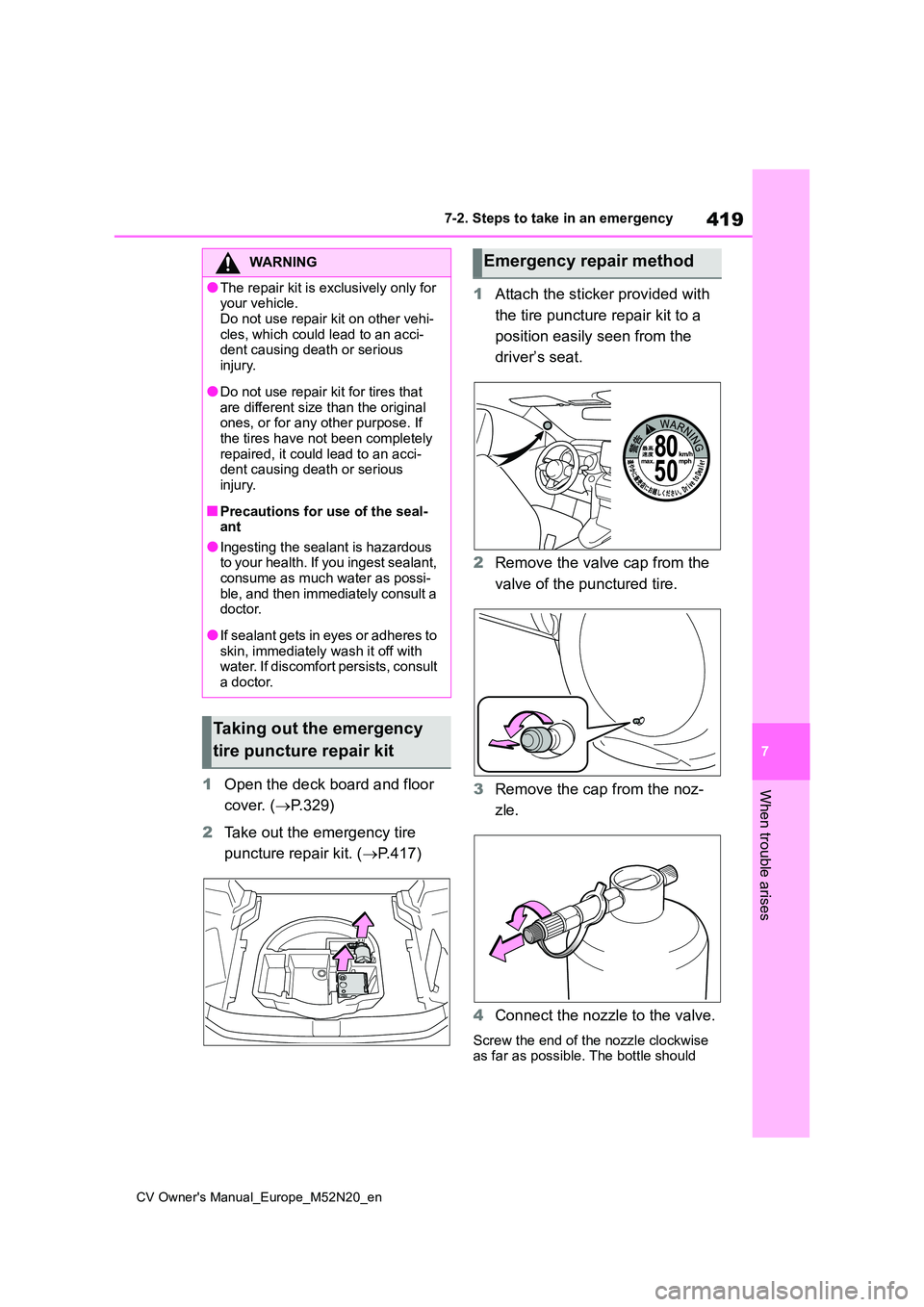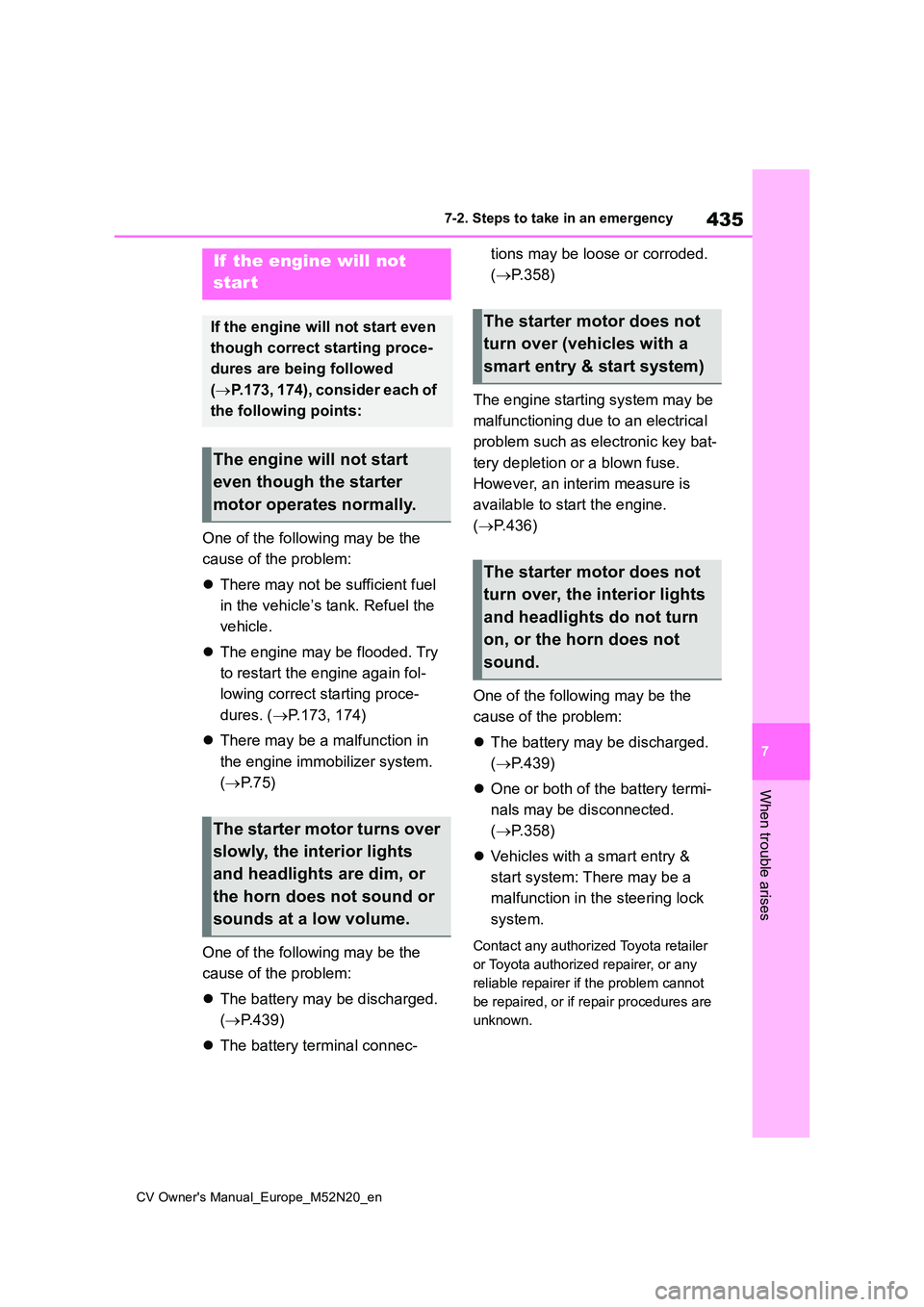Page 393 of 618
391
6
CV Owner's Manual_Europe_M52N20_en
6-3. Do-it-yourself maintenance
Maintenance and care
3Remove the light bulb.
4 Install a new light bulb.
5 Install the bulb base.
6 Install the back door cover.
WARNING
■Replacing light bulbs
●Turn off the lights. Do not attempt to
replace the bulb immediately after turning off the lights. The bulbs become very hot and may cause
burns.
●Do not touch the glass portion of
the light bulb with bare hands. When it is unavoidable to hold the glass portion, use and hold with a
clean dry cloth to avoid getting moisture and oils on the bulb. Also, if the bulb is scratched or dropped,
it may blow out or crack.
●Fully install light bulbs and any
parts used to secure them. Failure to do so may result in heat damage, fire, or water entering the light unit.
This may damage the lights or cause condensation to build up on the lens.
■To prevent damage or fire
Make sure bulbs are fully seated and
locked.
Page 397 of 618

395
7
CV Owner's Manual_Europe_M52N20_en
7-1. Essential information
When trouble arises
Vehicles with a smart entry &
start system
Press and hold the engine switch for 2
consecutive seconds or more, or press
it briefly 3 times or more in succession.
5 Stop the vehicle in a safe place
by the road.
If the door can be opened, open
the door and exit the vehicle.
If the door can not be opened,
open the window using the
power window switch and ensure
an escape route.
If the window can be opened,
exit the vehicle through the win-
dow.
If the door and window cannot be
opened due to the rising water,
remain calm, wait until the water
level inside the vehicle rises to
the point that the water pressure
inside of the vehicle equals the
water pressure outside of the
vehicle and then open the door
after waiting for the rising water
to enter the vehicle, and exit the
vehicle. When the outside water
level exceeds half the height of
the door, the door cannot be
WARNING
■If the engine has to be turned off while driving
●Power assist for the brakes and
steering wheel will be lost, making the brake pedal harder to depress and the steering wheel heavier to
turn. Decelerate as much as possi- ble before turning off the engine.
●Vehicles without a smart entry & start system: Never attempt to remove the key, as doing so will
lock the steering wheel.
If the vehicle is sub-
merged or water on the
road is rising
This vehicle is not designed to
be able to drive on roads that
are deeply flooded with water.
Do not drive on roads where
the roads may be submerged
or the water may be rising. It is
dangerous to remain in the
vehicle, if it anticipated that the
vehicle will be flooded or set a
drift. Remain calm and follow
the following.
Page 400 of 618

398
CV Owner's Manual_Europe_M52N20_en
7-2. Steps to take in an emergency
When using a flat-bed truck to
transport the vehicle, use tire strap-
ping belts. Refer to the owner’s
manual of the flat-bed truck for the
tire strapping method.
In order to suppress vehicle move-
ment during transportation, set the
parking brake and turn the engine
switch off.
If a tow truck is not available in an
emergency, your vehicle may be
WARNING
■When towing the vehicle
Be sure to transport the vehicle with
the front wheels raised or with all four wheels raised off the ground. If the vehicle is towed with the front wheels
contacting the ground, the drivetrain and related parts may be damaged.
NOTICE
■To prevent damage to the vehicle
when towing using a wheel-lift type truck
●Do not tow the vehicle from the rear
when the engine switch is off. The steering lock mechanism is not strong enough to hold the front
wheels straight.
●When raising the vehicle, ensure adequate ground clearance for tow-ing at the opposite end of the raised
vehicle. Without adequate clear- ance, the vehicle could be dam-aged while being towed.
■When towing a vehicle equipped with the Stop & Start system (if
equipped)
If it is necessary to tow the vehicle with all four wheels on the ground,
perform the following procedure before towing the vehicle in order to protect the system. Turn the engine
switch off and then start the engine or turn the engine switch to ON.
■Towing with a sling-type truck
Do not tow with a sling-type truck to prevent body damage.
Using a flatbed truck
Emergency towing
Page 402 of 618

400
CV Owner's Manual_Europe_M52N20_en
7-2. Steps to take in an emergency
5Securely attach cables or chains
to the towing eyelet.
Take care not to damage the vehicle
body.
6 Enter the vehicle being towed
and start the engine.
If the engine does not start, turn the
engine switch to ON.
7 Shift the shift lever to N and
release the parking brake.
Turn automatic mode off.
( P.187)
Multidrive: When the shift lever
cannot be shifted: P. 1 8 0
■While towing
If the engine is not running, the power assist for the brakes and steering will
not function, making steering and brak- ing more difficult.
■Wheel nut wrench*1, 2
Wheel nut wrench is installed in luggage compartment. ( P.427)*1: If equipped
*2: If your vehicles does not provide a
wheel nut wrench, you can purchase
it from any authorized Toyota retailer
or Toyota authorized repairer, or any
reliable repairer.
WARNING
Observe the following precautions. Failure to do so may result in death or serious injury.
■While towing
●When towing using cables or chains, avoid sudden starts, etc.
which place excessive stress on the towing eyelets, cables or chains. The towing eyelets, cables or
chains may become damaged, bro- ken debris may hit people, and cause serious damage.
●Do not turn the engine switch off.There is a possibility that the steer-
ing wheel is locked and cannot be operated.
■Installing towing eyelets to the vehicle
Make sure that towing eyelets are
installed securely. If not securely installed, towing eye-lets may come loose during towing.
■To prevent damage to the vehicle during emergency towing
Do not secure cables or chains to the suspension components.
Page 421 of 618

419
7
CV Owner's Manual_Europe_M52N20_en
7-2. Steps to take in an emergency
When trouble arises1Open the deck board and floor
cover. ( P.329)
2 Take out the emergency tire
puncture repair kit. ( P.417)
1 Attach the sticker provided with
the tire puncture repair kit to a
position easily seen from the
driver’s seat.
2 Remove the valve cap from the
valve of the punctured tire.
3 Remove the cap from the noz-
zle.
4 Connect the nozzle to the valve.
Screw the end of the nozzle clockwise as far as possible. The bottle should
WARNING
●The repair kit is exclusively only for your vehicle.
Do not use repair kit on other vehi- cles, which could lead to an acci-dent causing death or serious
injury.
●Do not use repair kit for tires that
are different size than the original ones, or for any other purpose. If the tires have not been completely
repaired, it could lead to an acci- dent causing death or serious injury.
■Precautions for use of the seal-ant
●Ingesting the sealant is hazardous to your health. If you ingest sealant, consume as much water as possi-
ble, and then immediately consult a doctor.
●If sealant gets in eyes or adheres to skin, immediately wash it off with water. If discomfort persists, consult
a doctor.
Taking out the emergency
tire puncture repair kit
Emergency repair method
Page 422 of 618
420
CV Owner's Manual_Europe_M52N20_en
7-2. Steps to take in an emergency
hang vertically without contacting the
ground. If the bottle does not hang ver- tically, move the vehicle so that the tire valve is located properly.
5 Remove the cap from the bottle.
6 Pull the hose out from the com-
pressor.
7 Connect the bottle to the com-
pressor.
Screw the end of the hose clockwise as
far as possible.
8 Make sure that the compressor
switch is (off).
9 Remove the power plug from
the compressor.
Page 437 of 618

435
7
CV Owner's Manual_Europe_M52N20_en
7-2. Steps to take in an emergency
When trouble arises
One of the following may be the
cause of the problem:
There may not be sufficient fuel
in the vehicle’s tank. Refuel the
vehicle.
The engine may be flooded. Try
to restart the engine again fol-
lowing correct starting proce-
dures. ( P.173, 174)
There may be a malfunction in
the engine immobilizer system.
( P. 7 5 )
One of the following may be the
cause of the problem:
The battery may be discharged.
( P.439)
The battery terminal connec-
tions may be loose or corroded.
( P.358)
The engine starting system may be
malfunctioning due to an electrical
problem such as electronic key bat-
tery depletion or a blown fuse.
However, an interim measure is
available to start the engine.
( P.436)
One of the following may be the
cause of the problem:
The battery may be discharged.
( P.439)
One or both of the battery termi-
nals may be disconnected.
( P.358)
Vehicles with a smart entry &
start system: There may be a
malfunction in the steering lock
system.
Contact any authorized Toyota retailer
or Toyota authorized repairer, or any
reliable repairer if the problem cannot
be repaired, or if repair procedures are
unknown.
If the engine will not
start
If the engine will not start even
though correct starting proce-
dures are being followed
( P.173, 174), consider each of
the following points:
The engine will not start
even though the starter
motor operates normally.
The starter motor turns over
slowly, the interior lights
and headlights are dim, or
the horn does not sound or
sounds at a low volume.
The starter motor does not
turn over (vehicles with a
smart entry & start system)
The starter motor does not
turn over, the interior lights
and headlights do not turn
on, or the horn does not
sound.
Page 439 of 618

437
7
CV Owner's Manual_Europe_M52N20_en
7-2. Steps to take in an emergency
When trouble arises
■When the electronic key does not work properly
●Make sure that the smart entry & start system has not been deactivated in
the customization setting. If it is off, turn the function on. (Customizable features: P.457)
●Check if battery-saving mode is set. If it is set, cancel the function. ( P.137)
Use the mechanical key (P. 1 1 7 )
in order to perform the following
operations:
1 Locks all the doors
2 Unlocks all the doors
■Key linked functions
1 Closes the windows (turn and hold)*
2Opens the windows (turn and hold)*
*: These settings must be customized at
any authorized Toyota retailer or
Toyota authorized repairer, or any reli-
able repairer.
If the electronic key
does not operate prop-
erly (vehicles with a
smart entr y & start sys-
tem)
If communication between the
electronic key and vehicle is
interrupted ( P.138) or the
electronic key cannot be used
because the battery is
depleted, the smart entry &
start system and wireless
remote control cannot be used.
In such cases, the doors can
be opened and the engine can
be started by following the pro-
cedure below.
NOTICE
■In case of a smart entry & start system malfunction or other key-related problems
Take your vehicle with all the elec- tronic keys provided with your vehicle to any authorized Toyota retailer or
Toyota authorized repairer, or any reli- able repairer.
Locking and unlocking the
doors